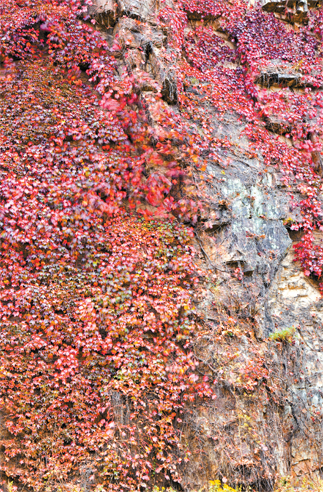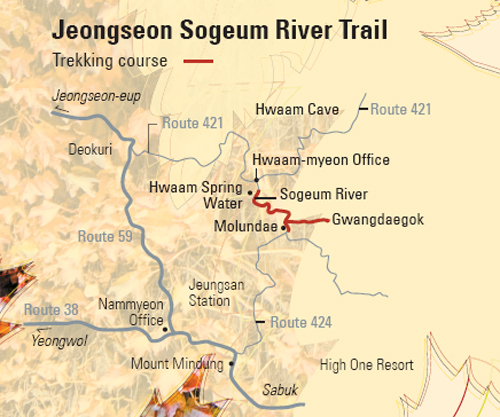In search of autumn splendor

The leaves of fall come in all kinds of beautiful colors. [JoongAng Ilbo]
In the fall of 2003, I visited Heullimgol (“gol” means valley) on Mount Seorak. I had a lot of trouble trying to find a guide for the ravine there that had finally opened for the first time in 20 years (it had been closed for nature preservation). Since its re-opening, however, there has been a sudden surge of visitors to the valley, which has led to concern about the area being damaged again.
Last year, I climbed Mount Jiri and trekked all the way to Chilseon Valley. It, too, had been closed and was finally opened to the public after 10 years, but only a limited number of people could enter the area at a time. Chilseon Valley, known as one of the roughest trails in the country, would surely be difficult to climb.
I finally settled on the Sogeum River Trail in Gangwon Province. It does not have a reputation for being dangerous and it is not an area where there are a whole lot of restrictions. It is tucked away from the main roads and has not seen much foot traffic. Unfortunately, however, as the area gets more and more developed, it is sure to lose some of its pristine qualities. The river is really one of the hidden gems Korea has to offer.

The changing of the leaves in fall is one of the most phenomenal things in nature, so it is no surprise that it has become a popular pastime. People say that witnessing the small miracles of nature - smelling the morning dew, gazing at shooting stars at night, seeing a rainbow after a downpour and watching the fall color are some of the things that have the ability to make people laugh and feel rejuvenated again.
By Son Min-ho [jbiz91@joongang.co.kr]
Jeongseon Sogeum River Trail
Route 38 is long and it takes a while to get out of the deep forest. After you enter Jungseon-eup, you still have to drive for another hour. Take Route 421, pass Mount Mindung and you’ll arrive at Molun-ri. This is where Molundae cliff is located. Hwang Tong-gyu, a poet, once described Molundae as serene and “a place where you can even hear flower petals falling onto the river.” It is located at the end of Dongdae Stream, a branch of the Sogeum River. The route from the cliff all the way to Hwaamyaksuteo, a spring water reservoir, is the Sogeum River Trail. Walking along the Molundae cliff is an extraordinary experience. If you walk over the cliff along Sogeum River for about 8 kilometers (5 miles), the ravine comes into view. Above the river is a steep cliff and a narrow path.
When you are looking up at the top of the cliff, you can see a pine tree standing tall against the blue sky. Along the rocks on the cliff, you can also spot the red blaze of leaves that have already been transformed. These leaves are from trees that have been wedged between the rocks, their branches wrapping around to embrace the rocks like vines. It is these trees that draw me here, because to me they look like human beings. The trees aren’t deeply rooted and are always blowing with the wind.
I start the trail at Hanchi Village past Molundae. Along the cliff is a narrow pathway covered with leaves and there is not much sunlight. There are marvelous rock formations on the corner of each path.
The trail ends at Hwaamyaksuteo. Here, the word “hwaam” means “picturesque rock.” The Sogeum River flows in between the cliff and divides Hwaam-ri. Hwaam-ri was supposedly named after the cliff.
To get there, head towards Hwaam-myeon, Jeongseon County, to view the autumn foliage. Take Route 424 and you’ll find the Sogeum River. Trekking along the river takes about three hours.
Then, you can stop at Hwaamyaksuteo Restaurant (033-562-8929) for gondeure bibimbap (rice mixed with herbs) for 6,000 won ($5). There must be at least two people to order. Seungwoo Travel Agency (www.swtour.co.kr) is offering a one-day hiking package (43,000 won) along the river on weekends. Reservations are required.
There are many ways to experience the colors of fall without going to the mountains. Some of the most beautiful spots around Seoul offer activities to keep you entertained as you look at the landscape.
The best time to see the rich oranges, bright yellows and deep reds on display is between the end of October and the beginning of November.
National Museum of Contemporary Art, Gwacheon
The trio of the National Museum of Contemporary Art, Seoul Zoo and Seoul Land are located close to one another at the foot of Mount Cheonggye, and all are famous for their beautiful landscaping. At the museum, the scenery at the outdoor sculpture park is a work of art in itself. The views at the zoo and the amusement park are equally as lovely.
Go to Seoul Grand Park Station on line No. 4, exit 4. There is a shuttle bus to the museum every 20 minutes. Admission to the museum is 3,000 won. It is closed on Mondays. For more information, call (02) 2188-6123 or visit www.moca.go.kr.
Ho-am Art Museum
There is a road near the museum called Everland Road that is a popular driving route. Take Yeongdong Highway and get off at the Maseong Interchange. Everland Road goes all the way to Everland amusement park and is about five kilometers long. Ho-am Art Museum is about halfway down the road. Not only is the road beautiful, the museum’s garden is gorgeous as well. The museum also has a traditional garden called Heewon that is decorated with stone lanterns and statues, trees and other intricacies that make this place all the more special.
The museum has 15,000 artifacts including over 100 national treasures. The scenery is most beautiful in a section called The Lake Quarter, which stretches from the museum to the west gate of Everland. Admission to Heewon garden is 4,000 won. Call (031) 320-1801 or visit http://haam.samsungfoundation.org.
Batangol Art Center
This place is situated in an ideal location for gazing at the leaves. As soon as you pass the point where the Bukhan River and Namhan River merge, you’ll be looking down the art center at the banks of the Namhan River. Make a stop along the riverbank to admire the view before heading to the art center.
Admission costs 3,000 won. The center also offers arts and crafts sessions for an additional fee. Closed Mondays and Tuesdays. For further information, call (031) 774-0745 or visit www.batangol.co.kr.
Changdeok Palace’s rear garden
When you hear about Joseon Dynasty (1392-1910) royal palaces, one immediately thinks of Gyeongbok Palace, but the place where the royal family spent the most time was Changdeok Palace. Changdeokgung, as it is known in Korean, is listed as a Unesco World Heritage site (Gyeongbok Palace is not). The palace’s rear garden was once known as Biwon, or secret garden.
Go to Anguk Station, line No 3, exit 3. The palace is a five minute walk from there. A guided tour of one hour and 20 minutes costs 3,000 won for adults and 1,500 won for children. Closed Mondays. For further information, call (02)762-8261 or visit www.cdg.go.kr.










with the Korea JoongAng Daily
To write comments, please log in to one of the accounts.
Standards Board Policy (0/250자)